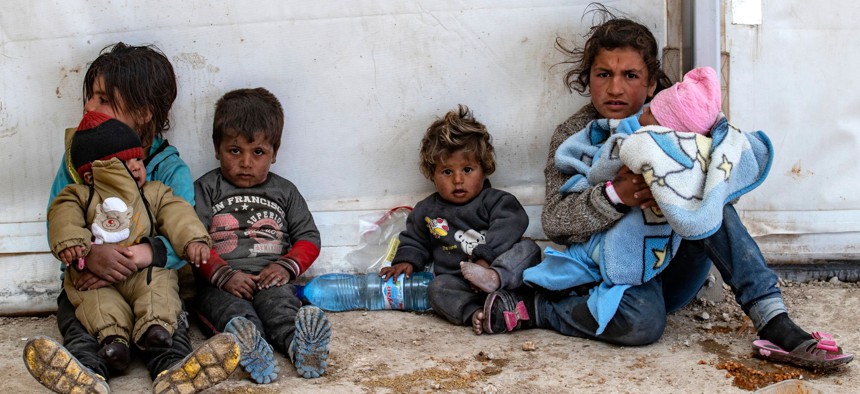
Syrian women and children sit by their belongings to wait for departure from the Kurdish-run al-Hol camp, which holds suspected relatives of ISIS fighters, in Hasakeh governorate of northeastern Syria, on March 18, 2021. DELIL SOULEIMAN/AFP via Getty Images
America Needs to Take Charge of the ISIS Aftermath
Two years after the fall of the caliphate, the world should not leave this to the SDF.
Two years ago today, the United States marked the end of the ISIS fight with its partner on the ground, the Syrian Democratic Forces, a force which lost 10,000 of its own women and men in battle. A Syrian marching band, clad in bright orange band uniforms beneath the yellow banner of the Syrian Democratic Forces, assembled at the Omar Oil Field in the March sun only feet from an American flag waving in the breeze and played the Star Spangled Banner.
The message that day from America’s partner as the world celebrated the end of the ISIS “caliphate” was clear: the SDF sacrificed its sons and daughters to keep the world safer from ISIS, but the United States, the counter-ISIS coalition, and the Syrian Democratic Forces defeated ISIS together. A top American diplomat extolled their sacrifices but made no assurances for the future. Now, as they continue to fight to keep ISIS at bay, the SDF wants to know what comes next.
Absent the leadership of greater powers like the United States, the work of dealing with the international crisis created by ISIS has fallen largely to this non-state actor, the SDF, and its political counterpart, the Syrian Democratic Council. The world has wished to walk away from its responsibility in dealing with the aftermath of the Islamic State, but an international crisis requires an international solution, and it should not be left to a non-state actor in northeastern Syria to deal with the very real nation-state problems that ISIS has created and caused worldwide. Indeed, the only reason that Europe and the United States have been able to keep the challenge of the ISIS aftermath at arm’s length until now is because the SDF, alongside U.S. and allied forces, has done the world’s groundwork.
Five months after that March ceremony, President Donald Trump ordered the withdrawal of all but less than 1,000 U.S. forces, clearing the way for a Turkish-backed incursion in to SDF-won territory that October. Larger geopolitical policy issues superseded the regional victories and opportunities the SDF’s victories made possible. Since then, the SDF has remained America’s partner on the ground as U.S. and SDF troops keep the pressure on what’s left of the Islamic State.
It’s not just about the fighting, though. The SDF also continues to hold in prisons (which the U.S. is helping to expand) roughly 2,000 foreign fighters of ISIS’s whose home countries will not take them back. Additionally, several thousand women from around the world who belonged to ISIS — and their children — remain in SDF-held camps. These women and children are living in political purgatory as most come from countries that not only do not want them back, but have no intention of allowing them to return. I have interviewed at Hol Camp, near the town of Hassakeh, women who came to ISIS territory in Syria from Russia, Egypt, British Guyana, and Germany, to name only a few, in order to be part of the caliphate. Some are disillusioned by the brutality the Islamic State meted out, even to their own followers. Others say that the idea of ISIS was good, even if its rulers were not. Their feelings are not unique to Syria. ISIS is growing its terror footprint outside the region in Afghanistan, Mozambique, as well as Mali, Nigeria, and Niger.
Two years ago, America’s top diplomat at the event that day marking the end of the Islamic State’s hold on terrain offered appreciation from the United States. “We could not have achieved any of this without the unwavering commitment and unity of our coalition and the tremendous sacrifice of our Syrian partners on the ground who have lost thousands of lives, taking back their homeland and helping to protect coalition homelands at the same time,” said Amb. William Roebuck, former deputy special envoy to the Global Coalition to Defeat ISIS. “We honor the sacrifices and the valor of the Syrian Democratic Forces in achieving this victory and express condolences for the many lives lost in the campaign.”
Now it is up to President Joe Biden to answer the three words that have hung over U.S. policy on Syria since 2011: “And then what?” Key architects of U.S. policy to stop ISIS, including Secretary of State Tony Blinken and former counter-ISIS envoy Brett McGurk, are once again serving in government. They have a half-decade of relationships built with the SDF. What is on the line? A pressing question of America’s national security — how the U.S. keeps the pressure on ISIS without deploying large numbers of U.S. service members abroad — and the record of how America treats its partners in arms and democracy.
On the second anniversary of the end of the fight against ISIS, both questions remain open.





